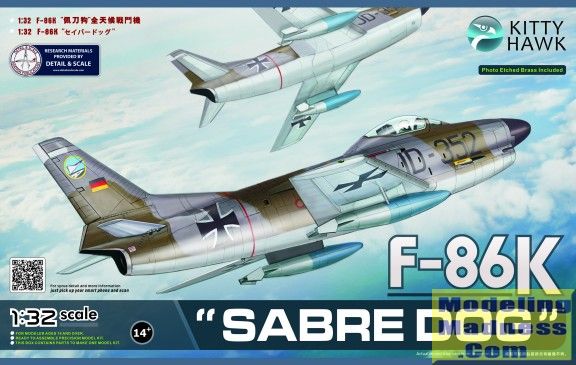
Kitty Hawk Models 1/32 F-86K Sabre
| KIT #: | KH 32008 |
| PRICE: | Should be in the $99.00 SRP range |
| DECALS: | Five options |
| REVIEWER: | Scott Van Aken |
| NOTES: |

| HISTORY |
The North American F-86D Sabre (sometimes called the "Sabre Dog" or "Dog Sabre") was a transonic jet all-weather interceptor of the United States Air Force and others. Based on North American's F-86 Sabre day fighter, the F-86D had only 25 percent commonality with other Sabre variants, with a larger fuselage, larger afterburning engine, and a distinctive nose radome.
The YF-95 was a development of the F-86 Sabre, the first aircraft designed around the new 2.75-inch (70 mm) Mighty Mouse Folding-Fin Aerial Rocket (FFAR), itself based on the German R4M rockets of WWII. Begun in March 1949, the unarmed prototype, 50-577, first flew on 22 December 1949, piloted by North American test pilot George Welch and was the first U.S. Air Force night-fighter design with only a single crewman and a single engine, a J47-GE-17 with afterburner rated at 5,425 lbf (24.1 kN) static thrust. Gun armament was eliminated in favor of a retractable under-fuselage tray carrying 24 unguided Mk. 4 rockets, then considered a more effective weapon against enemy bombers than a barrage of cannon fire. A second prototype, 50-578, was also built, but the YF-95 nomenclature was short-lived as the design was subsequently redesignated YF-86D.
The fuselage was wider and the airframe length increased to 40 ft 4 in (12.29 m), with a clamshell canopy, enlarged tail surfaces and AN/APG-36 all-weather radar fitted in a radome in the nose, above the intake. Later models of the F-86D received an uprated J-47-GE-33 engine rated at 5,550 lbf (24.7 kN) (from the F-86D-45 production blocks onward). A total of 2,504 D-models were built, equipping dozens of Air Defense Command squadrons in the US and many nation's air forces overseas.
On 18 November 1952, F-86D, 51-2945, set a speed record of 698.505 mph (1,124.1 km/h). Captain J. Slade Nash flew over a three km (1.8 mi.) course at the Salton Sea in southern California at a height of only 125 ft (38 m). Another F-86D broke this world record on 16 July 1953, when Lieutenant Colonel William F. Barns, flying F-86D 51-6145, in the same path of the previous flight, achieved 715.697 mph (1,151.8 km/h).
There was much interest among NATO countries regarding this aircraft, but they did not want to deal with the hassles of the fire control system and wanted guns, so a variant of the F-86D without the missiles and with four 20mm guns was proposed. There was a slight lengthening of the fuselage to accomodate the guns, but otherwise, the airframe was the same as the F-86D. The type saw quite a bit of service with NATO nations. It was a pleasant aircraft to fly and was relatively easy to maintain. The majority of F-86Ks were built by Fiat.
| THE KIT |
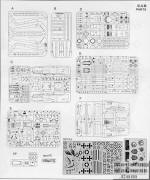 I
was hoping that Kitty Hawk Models would produce the F-86K. I'm a fan of Sabres
of any variant and having this one only makes me and hopefully others, very
happy. As you might expect, there is a great deal of commonality between this
kit and the earlier F-86D. First, let me refresh your memory on what comes in
the F-86D box.
I
was hoping that Kitty Hawk Models would produce the F-86K. I'm a fan of Sabres
of any variant and having this one only makes me and hopefully others, very
happy. As you might expect, there is a great deal of commonality between this
kit and the earlier F-86D. First, let me refresh your memory on what comes in
the F-86D box.
The box is huge as you would expect of a plane of this size. All of the sprues are individually packaged with the clear bits coming in a sturdy little box. The main decal sheet is huge and won't fit on the platen of my scanner. There is minimal photo etch, this material being used for the seat harness and inside the speedbrake.
Since most builds and kit descriptions start in the cockpit, so will I. The seat is made up of ten pieces, not including the p.e. This fits into a very nicely done cockpit tub that has a radio rack fixed to the back of it. The side consoles are separate bits and you can put decals over the detail already there if you so wish. Rudder pedals are included along with a single piece control stick and throttle.
Moving to the nose gear well, you have a choice of finned or lobed nose wheels so check your references to see which is appropriate for what you are building. The base of the nose gear well is molded into the bottom of the forward intake section. You then add the fore and side bulkheads to it with the rear bulkhead being part of the seven piece missile tray well. The kit does provide a complete intake that goes all the way to the intake compressor face of the engine.
The engine is quite complete with separate burner cans, braces and a full afterburner section. The engine comprises some forty pieces. Looking at the way the kit is designed, one could easily just build up a bare skeleton engine in order to have something to attach the intake and exhaust section to as it will be pretty well hidden once the fuselage is completed.
The forward fuselage has two halves with a separate lower fuselage piece that will contain each of the five piece main gear wells. The missile tray is six parts and from the look of things is engineered to be displayed in the lowered position. A full radar antenna is provided for the nose section, though the instructions again show this disappearing behind the radome. At this point, I should mention that there is no indication that any nose weight is needed, though there is ample room for it above the intake and in front of the cockpit.
There is a separate tail section to allow the different
forward fuselages for the D and K versions to be kitted. All the flight surfaces have separate control surfaces and it appears
that the flaps are molded in the down position. I should mention that Kitty Hawk
has already opened the holes for the pylons and this includes the Sidewinder
pylons. I'm not sure how many F-86Ks were actually outfitted with these.I should add
that Kitty Hawk has properly molded all the little vortex generators on the kit
so you don't have to try
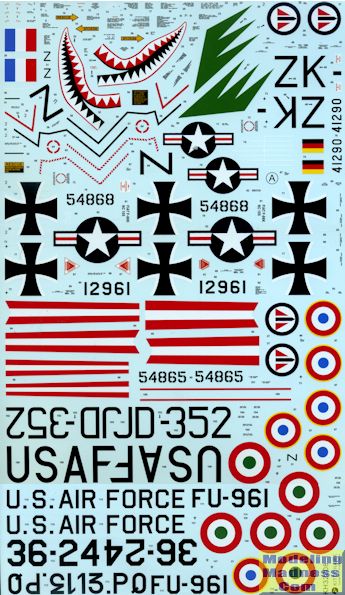 to duplicate these with teensy bits of p.e.
to duplicate these with teensy bits of p.e.
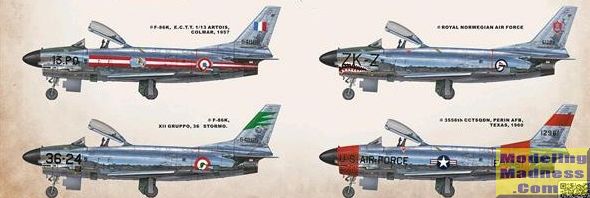 st
is the box art plane with JG 74 from mid 1964 and is the only camouflaged
plane on the sheet. Next is a French version with probably the nicest scheme
from ECTT 1/13 in 1957. Below it is an Italian plane from 12 Gruppo 36
Stormo with the nice green fin markings. The upper right is a shark mouth
version with the Norwegian Air Force. The final option is a USAF version
with the 3556th CCTS in Texas during 1960. This one has a lot
st
is the box art plane with JG 74 from mid 1964 and is the only camouflaged
plane on the sheet. Next is a French version with probably the nicest scheme
from ECTT 1/13 in 1957. Below it is an Italian plane from 12 Gruppo 36
Stormo with the nice green fin markings. The upper right is a shark mouth
version with the Norwegian Air Force. The final option is a USAF version
with the 3556th CCTS in Texas during 1960. This one has a lot
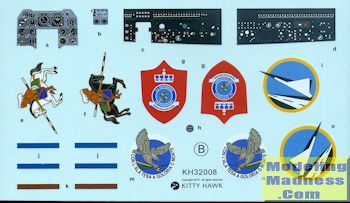 of
daglo paint and will be the brightest. While the USAF did not operate the
plane it did provide training for NATO crews as the weather in Texas is
generally better than in Europe and there is more space to fly the planes.
The main decal sheet is enormous and the decals are thin to the point that
they will require some skill in applying the long ones. Kitty Hawk's decal
maker has removed much of the clear carrier and so the longer letter/number
markings are quite difficult to install. I recommend applying those in
sections.
of
daglo paint and will be the brightest. While the USAF did not operate the
plane it did provide training for NATO crews as the weather in Texas is
generally better than in Europe and there is more space to fly the planes.
The main decal sheet is enormous and the decals are thin to the point that
they will require some skill in applying the long ones. Kitty Hawk's decal
maker has removed much of the clear carrier and so the longer letter/number
markings are quite difficult to install. I recommend applying those in
sections. | CONCLUSIONS |
I'm all for this one but then again, I'm biased as I like Sabres. Kitty Hawk kits need to be built like short run kits. The builder will need to make some adjustments to things and test fit everything prior to applying cement. It is not a simple kit and will require some skills to build it. To see how the similar F-86D builds, check out the review in the archives. Those who have the patience and the skills will be rewarded with a superb and fairly large model.
| REFERENCES |
http://en.wikipedia.org/wiki/North_American_F-86D_Sabre
The North American Sabre, by Ray Wagner, MacDonald & Co, 1963
Copyright ModelingMadness.com October 2015 Thanks to Kitty Hawk Models and Glen
Coleman for the preview kit. If you would like your product reviewed fairly and fairly quickly, please contact the editor or see other details in the
Note to
Contributors.